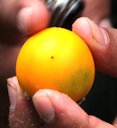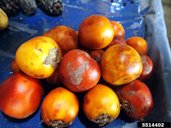| Cocona - Solanum sessiliflorum | |||||||||||||||||||||||||||||||||||||
|---|---|---|---|---|---|---|---|---|---|---|---|---|---|---|---|---|---|---|---|---|---|---|---|---|---|---|---|---|---|---|---|---|---|---|---|---|---|
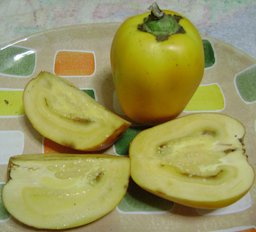 Fig. 1  Cocona, Solanum sessiliflorum 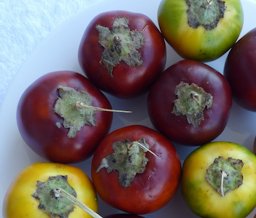 Fig. 2  S. sessiliflorum - red Cocona 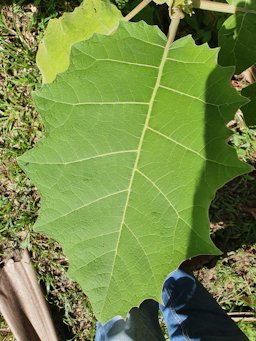 Fig. 3  S. sessiliflorum, Lamas Province, Peru 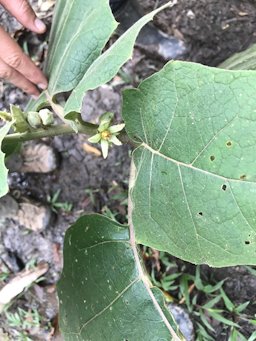 Fig. 4  Cocona, S. sessiliflorum, Mazan, Peru 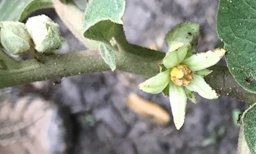 Fig. 5  Close-up fo the flower 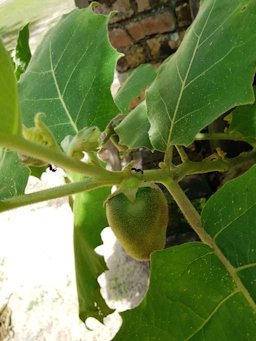 Fig. 6  Cocona S. sessiliflorum, Brasil 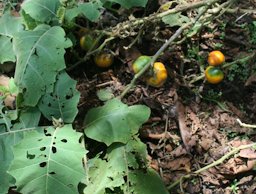 Fig. 7  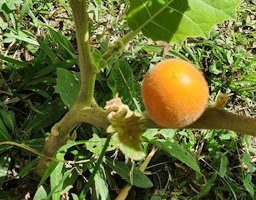 Fig. 8  Flower buds and fruit, Lamas Province, Peru 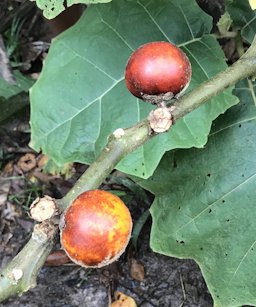 Fig. 9  Cocona fruit 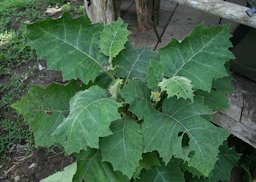 Fig. 13  S. sessiliflorum, Costa Rica 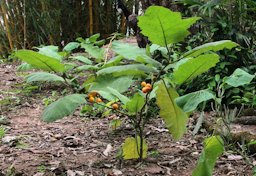 Fig. 14  S. sessiliflorum, Madre de Dios, Peru 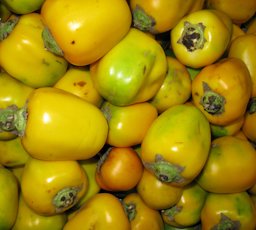 Fig. 15  |
Scientific
name Solanum sessiliflorum Dunal. Common names English: cocona, orinoco apple, peach tomato; Spanish: lulo grande, cubiyu, cocanilla, pepino, tamarillo, cubiu, tupiro; Brazil: cocona, cubiu, maná, tomate-de-indio (Portuguese); Columbia: be-tá-ka (kubeo), cocona, de-twá (taiwano, tatuya), coconilla, lulo, tupiru; French: tomate chauve souris; Guyana: orinoco apple; Hungarian: orinoco-paradicsom; Peru: cocona, kukush; Swedish: topiro; Venezuela: pupú (Arecuna), tupiru; Tupi language: kubi ́u 1,3,4,5 Synonyms S. alibile R.E. Schult., S. arecunarum Pittier (nom.nud.), S. georgicum R.E. Schultes, S. sessiliflorum var. sessiliflorum, S. topiro Dunal. 5,6 Relatives Naranjilla, S. quitoense; pepino, S. muricatum; tamarillo, S. betaceum Family Solanaceae (nightshade family) Origin Native to the Amazon and Orinoco river regions in South America Uses Food Height 3-6.5 ft (1-2 m) 5 Plant habit Perennial; erect, herbaceous shrub; much branched; becomes woody at maturity; no spines 3,4 Growth rate Fast Longevity 3-5 years 3 Trunk/bark/branches Several primary branches from its base; pubescent stems; densely white-hairy twigs 1,3,5 Pruning requirement Minimal; removal of yellow, dead leaves Leaves Large; simple, alternate; thin-textured; ovate; hairy on both sides; new shoots rusty-hairy on the underside 1,3,4 Flowers Clusters of 5-8 in leaf axils; five pale greenish-yellow petals; yellow stamens; campanulated calyx, remains attached to the fruit even after harvested 4 Fruit Berry; varied forms; thin, tough skin; coated with fuzz; orange-red when mature 3 Season All year Light requirement Full sun Soil tolerances Does well on scarified limestone; good drainage 1 pH preference Close to 6.0 3 Drought tolerance Does not tolerate flooded or wet soils 3 Wind tolerance Large leaves make it susceptible to wind damage 3 Cold tolerance Not frost hardy Plant spacing 3-8 ft (1.0-2.5 m) apart Roots Well-ramified; fairly superficial root system 3 Invasive potential * None reported Pest/disease resistance Susceptible to root knot nematodes Known hazard None reported Reading Material Cocona, Fruits of Warm Climates "New" Solanums, Perspectives on New Crops and New Uses, Purdue University The Cocona, Archives of the Rare Fruit Council of Australia The naranjilla (Solanum quitoense), the cocona (Solanum sessiliflorum) and their hybrid, NewCrop™, Purdue University Origin The spineless cocona is apparently unknown in the wild, having been observed by botanists only in cultivation from Peru and Colombia to Venezuela and bordering regions of Brazil. 1 Cocona comes from the upper Amazon region, specifically the eastern foothills of the Andes at altitudes of 200–1,000 m. This area extends from the higher Orinoco River region in Venezuela to the upper reaches of the Amazon in Ecuador, Colombia, Peru and Brazil. 3 This plant was cultivated widely in the upper Orinoco and Amazon basins before the arrival of the Europeans. Presently, it is still cultivated on a small scale in the same region and used both as a fruit and as a vegetable. It is little known outside of this area. It has been taken to several places including Florida, South Africa, Costa Rica and Puerto Rico but has not gained importance. Trials have been done in Honduras under low seasonal rainfall conditions and heavy soils with success. 3 Description At one time it was erroneously identified as Solanum hyporhodium A. Br. & Bouché. This binomial was dropped in favor of S. topiro HBK., which is now replaced by S. sessiliflorum Dunal. 1,4,5 Solanum sessiliflorum, known as cocona or tuppiro in Spanish-speaking countries or as cubiu in Brazil, is widely grown in the upper Amazon basin where it is used both as a fruit and as a vegetable. The plant is shorter than the naranjilla with large leaves, to 38 in. (95 cm) long, and maroon, orange-red or yellow fruit reaching a diameter of 4 in. (10 cm). 2 Leaves The alternate, ovate leaves with scalloped margins are downy with hard hairs on the upper surface, with prominent veins on the underside and softer hairs. The leaves have a very large leaf blade 27-35 in. (70-90 cm) by 14-16 in. (35-40 cm) which is oblique to the base and attached to the stem by a 0.8-2 in. (2-5 cm) petiole. Leaf veins are green instead of purple as on the naranjilla. 3 Flowers Flowers appear in the leaf axils in clusters of five to eight. Each flower is about 1-1.6 in. (2.5-4.0 cm) wide and they open sequentially on the stem. The flowers have five dark green sepals and five pale greenish-yellow petals that form a star with five yellow stamens and a 0.08-0.2 in. (2-5 mm) peduncle. Once the plant starts flowering, it continues to flower for the rest of its life with variable intensity and fruit production follows the same pattern. A plant can produce around 1,000 flowers during its lifetime but only 5–10% will set fruit. 3 The plant flowers almost continuously throughout the year, indicating that day length does not influence flowering. 3 Pollination The cocona is self-fertile. Bees are always visiting the flowers and carrying pollen, and natural crosses are common. 1 Fruit The fruit is a berry with several forms (Fig. 12) from ovoid (Martin et al., 1987) to spheric, oblate, oblong or conical-oval. Each fruit is 2-5 in. (6-12 cm) long and 2-3 in. (4-8 cm) wide, weighing from 0.85-8.5 oz (24-240 g), with a bluntly rounded apex. The thin, tough skin is coated with a peach-like fuzz formed by trichomes that stay strongly attached until the fruit matures; once the skin becomes smooth acquiring a golden to orange-yellow, burnt-orange, red, red-brown or deep purple red color these hairs are easily removed by rubbing with the hands or a piece of cloth. 3 When cut transversely, a cream-colored thick 0.2-0.3 in. (4-8 mm) hard flesh layer is found under the skin (“hoof ”) surrounding four compartments containing the fairly liquid, jelly-like, creamy pulp with numerous seeds. This hoof (Fig. 1) and the compartment walls are fairly hard and can be used either alone or mixed with the liquid pulp to prepare other products. The hard flesh has a faint tomato- like aroma and the liquid pulp has a pleasant acidity. The small 0.1-0.2 in. (2-4 mm), cream-colored seeds are flat and are not noticed during eating. 3
Fig. 10. Unripe fruit, Lamas Province, Peru Fig. 11. S. sessiliflorum, Madre de Dios, Peru Fig. 12. Assorted shapes, and maturation of the cocona fruit Varieties Two varieties are recognized, sessiliflorum and georgium. The former is spineless, while the last presents spines on branches and leaves. Lack of spines in sessiliflorum is probably a consequence of domestication processes. 4 There are not many defined cultivars. There are agro-types according the shape and size of the fruit. Peru distinguishes four types: (i) medium yellow fruit; (ii) round-yellow fruit; (iii) small purple-red fruit; and (iv) pear- shaped fruit. 1 The producer normally selects the best fruit from the higher yielding plants to obtain the seeds. 3 Harvesting The time from anthesis to maturation is about 100 days. Fruit at different stages of development are normally present on the plant year round. 3 Harvest is normally done once a week. Fruit pubescence should not affect harvesters although harvesting during warm hours in a dry climate can result in the hairs getting into the respiratory tract creating some discomfort, hence it is better to harvest during the early morning hours. 3 Fruit can be stored at room temperature 80-86 °F (27–30 °C) with good ventilation for 5-7 days. In the home refrigerator, fruit can be held for 1 month without loss of aroma and flavor. Frozen pulp can be held for up to 6 months without appreciable changes in color, flavor or aroma. 3 Propagation There are from 800 to 2,000 seeds in each fruit. New plants spring up voluntarily from seeds clinging to discarded rinds in full sun on disturbed ground in northern South America. 1 Seed propagation is not difficult since there is no dormancy. The pulp of mature fruit is placed in a blender with water and blended for a short period. This mixture is passed through a sieve and the seeds are separated by flotation eliminating all pulp residues that float. After seed cleaning, the seeds are dried in the shade between thin layers on newspaper; once dried, they are ready to be sown. 3 The seeds are planted 3/8 in (1 cm) deep in nursery beds in rows 8 in (20 cm) apart; or in polyethylene bags containing a 50-50 mixture of potting soil and sand. In each bag, or each hole, one puts 4 to 5 seeds expecting the emergence of 1 or 2 sturdy seedlings. 1 Production starts about 10-12 months after sowing with about 2-3 months in the propagation trays or bags, and 6-9 months in the field. 3 Climate In Florida and Trinidad, the cocona is grown at near sea-level. In Colombia, it is grown from sea-level to an elevation of 2,000 ft (610 m), while elsewhere in South America it thrives at altitudes up to 3,000 or 4,000 ft (910-1,200 m). 1 It thrives in areas with mean annual temperatures of 64-86 °F (18–30 °C) and average relative humidity of 85%. 5 Unlike the naranjilla, the plant needs full sun. 1 Planting Seedlings are transplanted to the field when 8 to 12 in (20-30 cm) high and they are spaced 5 to 7 ft (1.5-2.5 m) apart each way, depending on the fertility of the soil. Flowering commences 2 to 3 months after transplanting. The plants usually begin fruiting in 6 to 7 months from seed and will continue fruiting for several months. 1 Pruning Pruning practices are normally limited. Basal shoots are left to develop to form a low canopy. Maintenance pruning consists in eliminating the lower and old yellowish leaves, to improve ventilation, as well as any damaged or diseased parts. 3 Fertilizing Cocona prefers rich soils with high organic matter content. A soil analysis should be done to determine the proper amounts to be applied. In sandy soils, the addition of large amounts of manure is recommended. 3 A fertilizer formula of 10-8-10 NPK is applied 6 times during the year at the rate of 1.8 to 2.5 oz (50-70 g) per plant. 1 Irrigation Most cocona plants are grown without irrigation. Although in places with a long dry season or with little or no rain, furrow or drip irrigation is needed. The plant is very succulent, has a very large leaf area and therefore does not tolerate long periods of drought. Ideally, plants should be irrigated no less than every 7-10 days, with drip irrigation this would be almost daily. Water consumption is very high. 3 Pests/Diseases The cocona is prone to attack by rootknot nematodes (Meloidogyne sp.). 1 As with many other Solanaceae, cultivation is not recommended on land that has been used for other members of this family because of the potential for root rot and nematode problems to be present. It is preferable to rotate the land with a non-susceptible crop for a couple of years to eliminate or reduce the inoculum level. 3 Food Uses The ripe fruit is peeled and eaten out-of-hand by South American Indians. More sophisticated people use the fruit in salads, cook it with fish and also in meat stews. Sweetened, it is used to make sauce and pie-filling. It is often processed as a nectar or juice which, sweetened with sugar, is a popular cold beverage. 1 The “hoofs” can be boiled in syrup to eat as a sweet or can be canned as peach halves. The cooked “hoofs” are used to make jellies and jams. The juice and pulp do not oxidize as readily as naranjilla and this is an advantage. 3 In Brazil, the leaves are cooked and eaten as well. 1
Medicinal Properties ** In the last 30 years the characteristics of this species have been discussed and explained by different authors. Particularly frequent are references related to its potential uses in the food industry as jelly, juices, marmalades, and also to its effects on human health. Lately, some interest has emerged for exploring those effects on improving human health, particularly controlling high blood pressure, reducing sugar and cholesterol levels in blood, and overall effect on wellness. Also, the composition of the fruits has been explored, not only in terms of nutrient contents but also in terms of the secondary metabolite production. 4 General The flesh and inner pulp is of a pale-cream colour throughout, a fact which readily distinguishes this fruit from its two nearest relatives, the naranjilla (Solanum quitoense) and lulita (S. hirsutissimum), the pulp of which is a translucent green colour. 7 Other Edibles in the Solanum Genus: Naranjilla, S. quitoense Pepino, S. muricatum Tamarillo, S. betaceum Further Reading Biodiversity of Food Species of the Solanaceae Family: A Preliminary Taxonomic Inventory of Subfamily Solanoideae, Resources pdf List of Growers and Vendors |
||||||||||||||||||||||||||||||||||||
| Bibliography 1 Fruits of Warm Climates. Julia F. Morton. Miami, 1987. 2 The Encyclopedia of Fruit & Nuts. Edited by Jules Janick and Robert E. Paull, Cambridge, CABI, 2008. 3 Duarte, Odilo and Robert E. Paull. Exotic Fruits and Nuts of the New World. Cambridge, CABI, 2015. 4 "Exotic Fruits, Reference Guide." Zlibrary, Edited by S. Rodrigues, et al, 2018, b-ok.cc/book/3418912/a1bb16. Accessed 2 Dec. 2020. 5 Lim, T. K. "Edible medicinal and non-medicinal plants, Fruits, vol. 6." ZLibrary, 2013, b-ok.cc/book/2144921/a9ea16. Accessed 2 Dec. 2020. 6 "Solanum sessiliflorum Dunal. synonyms." The Plant List (2013), Version 1.1, www.theplantlist.org/tpl1.1/record/tro-29600313. Accessed 2 Dec. 2020. 7 Fennell, Joseph L. "The Cocona." Archives of the Rare Fruit Council of Australia, reference Foreign Agriculture, Vol. 12 (8) 1948, Mar. 1982, rfcarchives.org.au/Next/Fruits/SolanumFamily/Cocona3-82.htm. Accessed 3 Dec. 2020. 8 Yahia, Elhadi M. "Cocona." Postharvest biology and technology of tropical and subtropical fruits Volume 3: Cocona to mango, 2011, ZLibrary, b-ok.cc/book/1187553/f944f4. Accessed 3 Dec. 2020. Photographs Fig. 1 Dtarazona. "Cocona, whole and sliced fruit." Wikimedia Commons, 1 Mar. 2008, Public Domain, commons.wikimedia.org/wiki/Category:Solanum_sessiliflorum#/media/File:Cocona.JPG. Accessed 2 Dec. 2020. Fig. 2 "Solanum sessiliflorum, red cocona." Trade Winds Fruit, www.tradewindsfruit.com/solanum-sessiliflorum-red-cocona-seeds. Accessed 4 Dec. 2020. Fig. 3,8,10 jimmylittle. "Cocona Solanum sessiliflorum. Lamas Province, Peru." iNaturalist Research Grade Observations, 25 Nov. 2014, (CC BY-NC 4.0), Image Cropped, www.inaturalist.org/photos/54409279. Accessed 4 Dec. 2020. Fig. 4,5 achemteacher. "Cocona Solanum sessiliflorum. Mazan, Peru." iNaturalist Research Grade Observations, 45475598, 8 July 2019, (CC BY-NC 4.0), Image Cropped, www.inaturalist.org/photos/45475598. Accessed 3 Dec. 2020. Fig. 6 jairmaia. "Cocona Solanum sessiliflorum. Brasil." iNaturalist Research Grade Observations, 16 Apr. 2018, (CC BY-NC 4.0), www.inaturalist.org/photos/11010934. Accessed 4 Dec. 2020. Fig. 7 Xaver, Franz. "Solanum sessiliflorum, Costa Rica." Wikimedia Commons, 17 Mar. 2010, (CC BY-SA 3.0), GFDL, Image Cropped, commons.wikimedia.org/wiki/File:Solanum_sessiliflorum_2.jpg. Accessed 2 Dec. 2020. Fig. 9 achemteacher. "Cocona Solanum sessiliflorum. Mazan, Peru." iNaturalist Research Grade Observations, 45475598, 8 July 2019, (CC BY-NC 4.0), Image Cropped, www.inaturalist.org/photos/29146295. Accessed 3 Dec. 2020. Fig. 11 Rebelo, Tony. "Cocona Solanum sessiliflorum. Madre de Dios, Peru." iNaturalist Research Grade Observations, 25 Nov. 2014, (CC BY-NC 4.0), Image Cropped, www.inaturalist.org/observations/20145631. Accessed 4 Dec. 2020. Fig. 12 Cranshaw, Whitney. "Cocona (Solanum sessiliflorum) Dunal fruit." Colorado State University, Bugwood.org, IPM Images, no. 5514402, Uploaded 4June 2014, Updated 7 Oct. 2024, Bugwood, (CC BY 3.0 US), www.ipmimages.org/browse/detail.cfm?imgnum=5514402. Accessed 4 Dec. 2020. Fig. 13 Xaver, Franz. "Solanum sessiliflorum, Costa Rica." Wikimedia Commons, 17 Mar. 2010, (CC BY-SA 3.0), GFDL, commons.wikimedia.org/wiki/File:Solanum_sessiliflorum_1.jpg. Accessed 2 Dec. 2020. Fig. 14 Rebelo, Tony. "Cocona Solanum sessiliflorum. Madre de Dios, Peru." iNaturalist Research Grade Observations, 25 Nov. 2014, (CC BY-NC 4.0), Image Cropped, www.inaturalist.org/observations/20145710. Accessed 4 Dec. 2020. Fig. 15 "Cocona, Solanum sessiliflorum." Trade Winds Fruit, www.tradewindsfruit.com/content/cocona.htm. Accessed 3 Dec. 2020. * UF/IFAS Assessment of Non-native Plants in Florida's Natural Areas ** Information provided is not intended to be used as a guide for treatment of medical conditions. Published 4 Dec. 2020 LR. Last update 10 Apr. 2023 LR |
|||||||||||||||||||||||||||||||||||||

